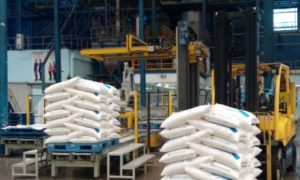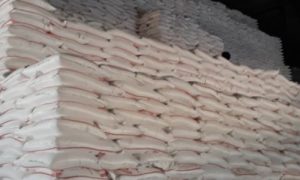India’s ethanol policy tilts heavily to grains, squeezes sugar sector

India’s ethanol program is shifting from sugarcane to grain-based feedstocks. In 2025-26, only 28% of ethanol orders are from sugar sources, while 72% come from maize and FCI rice. Sugar mills fear reduced revenues and delayed cane payments. Grain distilleries also face allocation imbalances, with capacity exceeding current blending demand.
NEW DELHI – India’s ethanol blending program, once designed around surplus sugarcane, is now increasingly shaped by grains. Sugar industry officials say pricing differentials and logistics-based procurement rules have sharply tilted most ethanol supply orders towards grain-based feedstocks.
For the upcoming ethanol supply year 2025-26 (Nov-Oct), oil marketing companies have so far placed supply orders for 10.5 billion litres of ethanol. Of this, only about 28% will come from sugar-based feedstocks such as cane juice, and B-heavy and C-heavy molasses. The remaining 72% has been contracted from grain-based feeds, mainly maize and surplus rice from the Food Corp. of India.
This was not always the case. In 2019-20, oil companies purchased 1.57 billion litres of ethanol from the sugar sector, accounting for 91% of total ethanol orders. In 2022-23, the sugar sector had a 70% supply share in the ethanol blending program.
However, from 2023-24, sugar’s share in the ethanol blending program has consistently declined and grain-based feedstocks such as maize and rice have caught up. In 2023-24, a General Election year, initial gross sugar output was estimated to fall 9-12% on year. Amid concerns over sugar supply, the government banned ethanol production from most sugarcane feedstocks to check prices in a poll-bound year.
However, to not trail in blending progress and fill the gap left by cane feedstocks, the government incentivised ethanol production from grains such as maize. Next year, the government lifted the restriction on cane-based ethanol, but the sugar sector has been struggling to regain the supply share it lost to grains in the last two years.
“We are looking at a fine calibration of the (feedstock) blend. From 91% we are down to 28%. We are not saying make it 91% again, even 40-50% would healthily recalibrate the industry,” Madhav B. Shriram, managing director of DCM Shriram Industries Ltd., said.
2025-26: High offers, low orders
Despite distillers bidding enthusiastically to supply 4.72 billion litres of ethanol from sugar-based feedstock, oil companies placed orders for only 2.89 billion litres, according to the Indian Sugar & Bio-Energy Manufacturers Association. As per experts, this happened because of the oil companies’ ethanol procurement policy. While allocating ethanol orders, oil marketing companies follow certain criteria to prioritise distilleries based on feedstock and location.
ISMA Director General Deepak Ballani explains: “Priority (first comes) for cooperative (sugar mills with distillation capacity), then your DEPs (dedicated ethanol plants), and DEP is mostly grain, after DEP comes sugarcane juice, B heavy and C heavy.”
Though cooperative mills are preferred in allocation, their distillery capacities are small, with just 560 million litres, Ballani said. But that is not the case with dedicated ethanol plants, supplying 3.5 billion litres, he added. Also, most of the dedicated ethanol plants run on grain-based feedstocks.
These “modalities” that prioritise grain feedstocks have effectively sidelined sugarcane-based feedstocks, Ballani said. According to ISMA, the government’s ethanol allocation policy has created “sectoral distortion” due to the high weightage given to grain-based ethanol. These imbalances will hurt the sugar sector’s ethanol revenues, which could delay cane payments and thereby prompt farmers to move away from sugarcane cultivation in the long run, ISMA said.
The government’s push for grain-based ethanol is also creating troubles for allied industries of both grain and oilseed, the association said. Distilleries producing ethanol from grains have been flooding the animal-feed market with distillers’ dried grains with solubles, or DDGS, a protein-rich by-product that directly competes with the traditional animal feeds such as wheat bran, rice bran, and oilmeals. These industries say that too much DDGS from maize-based ethanol is pulling down the prices of their own by-products, which form a significant share of their processing margins.
“We have also seen the effect of too much maize cultivation in terms of oilseed and soybean,” Ballani said. Now that maize has suddenly secured demand from the food-fuel-feed industry, farmers have increased maize cultivation by 12.6% in the recent kharif season. They have shifted away from other crops, such as pulses and soybean, to maize. Soybean acreage fell 7% on year and pulses rose marginally by 1.2% in the kharif season.
Ethanol supply: A crowded market
Interestingly, the grain sector is also not happy with oil marketing companies’ methodology in allocating ethanol supply orders. Though they secured a whopping 72% of the total ethanol orders in 2025-26, there are concerns of “underutilised capacities” and “imbalances” in allocations among the grain-based distilleries as well.
However, their pain point is not another competing feedstock, but the rise of new distilleries in deficit areas. The current allocation methodology “favours new entrants in deficit zones while sidelining operational units with surplus capacity,” the Grain Ethanol Manufacturers’ Association said in a release. Deficit zones refer to areas that have an ethanol supply relatively lower than what oil companies require, and surplus zones refer to areas that produce more ethanol than is needed locally.
As per the tender document, supply offers from distillers located in deficit zones “shall be accepted in full for allocation.” This priority given for distilleries in deficit areas has deprived many surplus-zone-based operational distilleries of adequate supply orders, the association said.
While the policy aims to promote local sourcing, it is being implemented in a way that disadvantages surplus regions, which already house large, operational ethanol units, it added. A preliminary reading of the ethanol allocation results shows that oil companies have given many supply orders eastward, especially for relatively new commissioned grain-based distilleries in Bihar.
While this promotes decentralised ethanol sourcing, traditional ethanol hubs like Maharashtra and Karnataka are dismayed. Earlier, ethanol was flowing from surplus to deficit regions, which ensured enough markets for these surplus zones. “So, our alcohol was flowing to those states. Now, with the advent of the maize-based ethanol, which they are making locally and producing locally, all their logistics costs are better than ours. So, the OMCs are then going to pick it up from them,” Shriram said.
Shriram explains the rationale: “The government is looking at it (ethanol supply allocations) in a very calibrated way. One challenge is how to ensure better remuneration for farmers. Maize, which used to sell at INR 12-INR 14 a kilo, is now higher than INR 24 a kilo.” While the ethanol program supported maize prices and cultivation, it had brought down soybean and pulse cultivation. “We are already importing oilseeds and pulses. So, they are calibrating it, they are studying the whole situation,” Shriram added.
“The government also has a storage problem of foodgrains (rice),” Shriram said. As of Oct. 1, rice stocks in the central pool were at a two-decade high for the month at 35.6 million tonnes, up 15% on year. With rice stocks swelling in government godowns, it has mandated distillers to use rice from the Food Corp. of India to produce 40% of their grain-based ethanol.
While the government seems to be juggling between ensuring food security, managing surplus feedstocks, diversifying feedstocks and locally procuring ethanol, the ethanol supply ecosystem is scrambling to secure demand. The biofuel demand market is essentially policy driven and not organic.
India has achieved 20% ethanol blending with petrol, and the government cannot simply ramp up blending mandates solely because distilleries have expanded their capacities. Distillers, irrespective of feedstocks and location, are pushing for the adoption of flex-fuel vehicles and higher ethanol blending with petrol. However, higher ethanol blends are struggling to win consumer confidence and automobile compatibility.
India’s annual ethanol production capacity is estimated around 18 billion litres, while oil companies’ demand is only about 11 billion litres. “They could have planned capacities in a planned manner and also worked on the demand side-by-side,” Ballani said. End
To Read more about Ethanol Industry & Bio Energy News, continue reading Agriinsite.com
Source : Informist

















